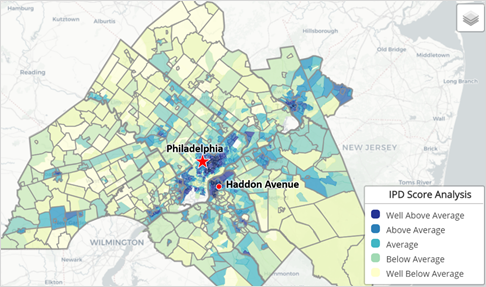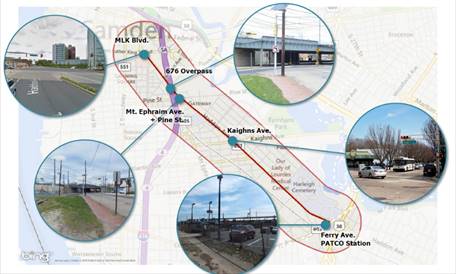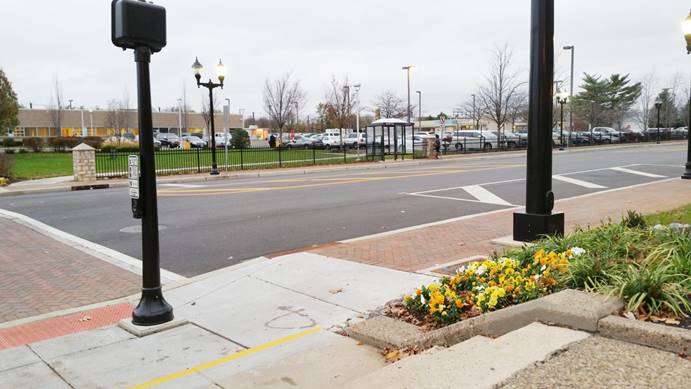US Department of Transportation
FHWA PlanWorks: Better Planning, Better Projects
Improving Public Health in the Haddon Avenue Corridor
Delaware Valley Regional Planning Commission
This case study is an excellent example of integrating health into corridor planning studies. Although the Delaware Valley Regional Planning Commission did not use PlanWorks, the PlanWorks Health in Transportation Application will be very useful in helping other agencies collaborating for a similar purpose.
Executive Summary
As part of an unfunded corridor study, DVRPC convened a health–focused Advisory Group to identify opportunities for projects that aligned with transportation and public health goals. Noteworthy characteristics of this study include:
- DVRPC created an Advisory Group, which included public health stakeholders,
- The Advisory Group mutually–developed criteria for project selection, and
- The study focused on opportunities to improve transportation options and public health status within larger planned projects.
The Delaware Valley Regional Planning Commission (DVRPC), the metropolitan planning organization for the Greater Philadelphia region, conducted a study of the Haddon Avenue Corridor in the city of Camden, New Jersey, as an opportunity to test the Federal Highway Administration's Health in Transportation Corridor Planning Framework (Framework). DVRPC, which had been incorporating health into its planning processes for a number of years, participated in this test as a means to identify opportunities to improve public health conditions in an important corridor, as well as to expand staff capabilities in planning for health and transportation.
DVRPC worked closely with stakeholders from the local health community to share information about public health conditions and planned projects and initiatives in the corridor, identify public health issues in key areas, propose infrastructure improvements to address health issues, and jointly develop a methodology to prioritize improvements. Together they created a list of planned, ongoing, and programmed projects in the area, which can be used as a foundation to add supplemental infrastructure improvements. Small–scale projects, primarily bicycle and pedestrian amenities, could be added to larger–scale capital projects, reducing the effort required for planning and implementation. Finding opportunities to add on these small–scale improvements can expedite implementation, which will more quickly improve the quality of life for the community along the corridor.
Agency's Challenge
DVRPC's jurisdiction includes nine counties across the states of Pennsylvania and New Jersey. In recent years, DVRPC has embraced health as a critical element in the planning process. The agency has a dedicated Healthy Communities Task Force, a Healthy Communities Planning program, and a focus on age–friendly communities. The agency also took a targeted look at health issues and equity in its 2016 Coordinated Human Services Transportation Plan, Equity Through Access .
Located in southeastern Camden, Haddon Avenue is an important connection between downtown Camden and the surrounding suburbs. Haddon Avenue is home to two hospitals, which are also two of Camden's biggest employers: Cooper University Health Care and Our Lady of Lourdes Medical Center. Additionally, Haddon Avenue functions as a main street for a number of residential neighborhoods and business communities, providing places for both residents and visitors to shop, eat, and gather. While this area was subject to new growth and positive development, primarily related to the health industry, communities within the corridor were challenged with high levels of poverty, unemployment, and safety issues (See Figure 1, showing high Indicators of Potential Disadvantage (IPD) scores [1] in southeast Camden, where Haddon Avenue is located). Safety concerns and a lack of bicycle and pedestrian infrastructure hindered opportunities for active transportation. In the four years prior to the study, there were approximately 250 vehicle crashes and 30 bicycle and/or pedestrian crashes within the study area. The corridor had gaps in the sidewalk network and lacked parks and other open spaces for recreation. The absence of open space is especially concerning considering Camden City's high rate of obesity (38 percent). DVRPC considered how transportation investments could leverage other planned developments and improvements to make a positive impact on the local community.

Figure 1: Map Detailing High Concentrations of Underserved Households in DVRPC Communities
FHWA Health in Transportation Corridor Planning Framework
In 2014, the Federal Highway Administration (FHWA) selected DVRPC to test the Health in Transportation Corridor Planning Framework (Framework) by applying the process to a planning study. FHWA developed the Framework as a guide for transportation planners and other professionals to consider potential public health impacts during the corridor planning process. The Framework provides guidance for incorporating health concerns at each stage of a planning process, offers questions to consider while engaging stakeholders, and includes references for health data and other resources. As health issues and priorities vary by community, thoughtful collaboration with public health stakeholders can direct transportation investment towards strategies that will best meet a community's specific health goals. DVRPC, along with four other test agencies, applied the Framework to existing corridor planning studies with technical assistance provided by FHWA. Case studies documenting their experience are available on the FHWA website at Testing the Health in Transportation Corridor Planning Framework . There are examples of other agencies interested in using the Framework on the website also.
DVRPC chose to apply the Framework to an unfunded corridor study of Haddon Avenue in the city of Camden. In addition to identifying opportunities to improve health in the corridor, DVRPC had an interest in leveraging planned bicycle and pedestrian improvements and new linkages between the hospital on Haddon Avenue and the commuter rail station.
Agency goals for this study included the following:
- Build capacity within DVRPC to integrate public health into transportation planning;
- Develop a comprehensive understanding of completed, ongoing, programmed, and planned infrastructure projects in the corridor;
- Describe the communities along the corridor, including any challenges and public health issues; and
- Propose infrastructure improvements to address multiple corridor–specific goals, especially those aligned with projects planned or in development.

Figure 2. Health in Transportation Corridor Planning Framework. FHWA
Defining Deficiencies and Opportunities with Stakeholders
Building an Advisory Group
The process followed by DVRPC can be connected to these key decisions:
- COR–1. Approve Scope of Corridor Planning Process. DVRPC identified stakeholders who could help define the scope of the corridor plan by bringing their knowledge of planned projects, public health, and baseline data for the local community.
- COR–2. Approve Problem Statements and Opportunities. The Advisory Group helped develop the problem statements and opportunities for the study, using a public health lens.
- COR–5. Approve Evaluation Criteria, Methods and Measures. The Advisory Group worked with DVRPC to develop criteria for selecting a focus area and set of projects to meet goals for the corridor.
At the start of the corridor study, DVRPC identified a group of stakeholders to form an Advisory Group, including organizations who had not previously participated in corridor planning processes (shown here in italics). Many different organizations have an interest in public health, though from different perspectives. Public health spans a wide array of topics such as chronic diseases, traffic safety, mental health, air quality–related conditions (such as asthma), obesity, and food/nutrition access. The stakeholders who participated in this Advisory Group included healthcare professionals, developers working on a transit village in the corridor, advocacy groups, representatives from economic development and business improvement districts. These stakeholders brought their knowledge and experience with public health, local communities, and planned projects and other initiatives within the corridor.
Advisory Group members included the following:
- Bicycle Coalition of Greater Philadelphia
- Camden Coalition of Healthcare Providers
- Camden County Department of Health and Human Services
- Camden County Improvement Authority
- Camden County Police Department
- Camden County Senior and Disabled Citizen Services
- City of Camden, Department of Development and Planning
- City of Camden, Mayor's Office
- Cooper Health System
- Cooper Medical School at Rowan University
- Cooper's Ferry Partnership
- Cross County Connection TMA
- Grapevine Development
- Our Lady of Lourdes Health System
- New Jersey Conservation Foundation
- NJTransit
- Parkside Business & Community in Partnership
- Port Authority Transit Corporation (PATCO)
Gathering Data and Developing Problem Statements
DVRPC held two Advisory Group meetings to gather baseline data and define public health issues in the corridor. In the first Advisory Group Meeting, DVRPC shared background information on the corridor (data gathered from traditional data sources, including the American Community Survey) and Advisory Group members presented on studies, initiatives and planned projects along the corridor. DVRPC created custom maps based on both the traditional data sources and new inputs from the Advisory Group.
After discussing baseline conditions of the corridor, the group defined "public health" for the context of this study. A clear vision of what constituted public health needs in the community helped guide the discussion of issues and possible solutions.
In this context, public health needs were defined as:
- Access to healthcare.
- Access to healthy foods.
- Access to green space.
- Improvement of air quality.
- Safety of bicycle and pedestrian travelers and automobile users.
- Bicycle and pedestrian facilities supportive of physical activity.
Considering these needs and baseline data, the Advisory Group identified public health issues for the corridor. DVRPC staff wrote problem statements based on these issues, which were as follows:
- Car and bus movement at some intersections makes navigating the streets difficult for walking and bicycling.
- Poor pavement conditions and older roads make bicycling difficult and unsafe.
- Striping is worn and no longer distinguishable in many areas, making it dangerous for pedestrians.
- Poor lighting exists under overpasses.
- Land use and transportation decisions are not well integrated.
Study Area Focus and Project Selection
In the second Advisory Group meeting, the group selected five potential focus areas where improvements would have the strongest impact on public health in the corridor (Figure 3). For each focus area, DVRPC described the major issues and opportunities for improvements, focusing on those aligned with existing or planned developments and infrastructure projects. The improvements were primarily related to bicycle and pedestrian facilities and amenities, and connecting gaps in the network.
DVRPC and the Advisory Group jointly developed criteria to evaluate each of the focus area improvement sets, of which one or two would be identified in the study as priority projects. Based on these criteria, input from the Advisory Group DVRPC selected the Ferry Avenue PATCO Station and Venner Street focus area improvements as those that would best meet the goals for the corridor.
The criteria for focus area improvements were as follows:
- Achievable.
- Not already addressed by an ongoing project.
- Presents the biggest opportunity to address public health concerns.
- Impacts a large portion of constituents.
- Recommendations could be adopted and carried forward by a project sponsor.
- Public health data, stakeholders, and potential impact could improve a potential competitive funding application.
The proposed improvements to the Ferry Avenue focus area included adding curbs and sidewalks, pedestrian lighting, crosswalk striping and a bus shelter. These amenities would make it easier and safer to walk from the Ferry Street Station to the Our Lady of Lourdes Hospital or make transit connections to surrounding neighborhoods. Government agencies, developers, and other partners would be able to incorporate these small–scale projects into plans for complete streets improvements or other upgrades along Haddon Avenue. Pedestrian safety improvements may also coincide with the anticipated development of a new school in the area.

Figure 3: Focus areas of Haddon Corridor. DVRPC, 2015.
Stakeholder Collaboration
From the outset, DVRPC was clear that all final decisions would be the agency's responsibility. However, an important element of this project was to work closely with an Advisory Group and a diverse group of stakeholders to collect better data and insights for the corridor . DVRPC structured the Advisory Group meetings to give the stakeholders a platform to share their data, insights, and priorities. Stakeholders prepared presentations for the meetings and played an active and vocal role in the study. Giving the stakeholders a platform to present at meetings contributed to an environment of mutual respect among DVRPC and the stakeholders.
Through participation in the Advisory Group, the stakeholders gained a deeper understanding of the community, challenges, and planned projects in the corridor. The process increased each organization's awareness not only of the work conducted by other Advisory Group members in the corridor, but also of the connections between the built environment and public health. Stakeholder organizations may find new champions for their projects among their Advisory Group members, knowing that many of their projects contribute to shared goals.
Health industry stakeholders helped DVRPC identify challenges in planning for health and transportation, such as the lack of corridor–level community health data. One of the stakeholders, Camden Coalition of Healthcare Providers, contributed studies on several health issues, including diabetes, asthma, and obesity, and provided a spatial analysis of areas with disproportionately high percentages of emergency room visits. This study demonstrates the value of working with stakeholders in a variety of professions who can provide valuable information or insights that a planning agency may not otherwise possess.
Key Outcomes
A key outcome of this work was the list of focus areas and small–scale improvements that can address health and transportation goals, primarily through active transportation infrastructure. Enhancements to planned projects can likely be implemented quickly as most of the Federal requirements (such as environmental review) may have been fulfilled during the planning process for the main project.
In 2017, the City of Camden, working with the Coopers Ferry Partnership and Camden County, completed Phase II of the Haddon Avenue Roadway Transformation project, which included implementing some of the improvements proposed in the Haddon Avenue Corridor Study (Figure 4).

Figure 4: Pedestrian improvements constructed as part of the Haddon Avenue Transformation Project. © Remington & Vernick Engineers.
The value to DVRPC in collaborating with the public health community was demonstrated throughout this process. DVRPC documented their work on Haddon Avenue in a case study in their updated 2016 Coordinated Human Services Transportation Plan.
The Haddon Avenue corridor study helped to illustrate both the value that a health lens adds to the planning process and the role that DVRPC could play in supporting healthy communities. Since undergoing the Haddon Avenue corridor study, DVRPC has greatly expanded its Healthy Community Planning work. In 2014, DVRPC convened a day–long workshop on the intersection of planning and public health. This one–day event led to the creation of the Healthy Communities Task Force (HCTF), which provides a venue for people interested in fostering healthy communities to learn about other communities that are successfully integrating planning and public health. The HCTF meets three to four times per year and has held meetings on a variety of topics, including Segregation and Health, Health and Climate Change, Housing, Aging–Friendly Communities, and Active Transportation and Equity. DVRPC is also continuing to work in Camden on a number of health–related issues. They convened a one–day workshop in August 2018 to discuss the transportation gaps to healthy destinations in Camden. They are also currently working with the City of Camden to develop a Health Element for the city's Master Plan.
For More Information
Contacts
Alison HastingsOffice of Communications and Engagement
Manager
ahastings@dvrpc.org Amy Verbofsky
Office of Environmental Planning
Senior Planner
averbofsky@dvrpc.org
Resources
[1] IPD scores classify the concentration of the populations of interest under Title VI and EJ present in every census tract in the region. For more information, see: https://www.dvrpc.org/webmaps/IPD/#page2
